Click on images to enlarge
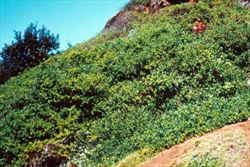
infestation (Photo: Land Protection, QDNRW)

habit (Photo: Land Protection, QDNRW)

habit (Photo: Jackie Miles and Max Campbell)
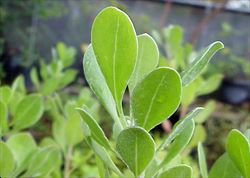
leaves with cottony down (Photo: Sheldon Navie)
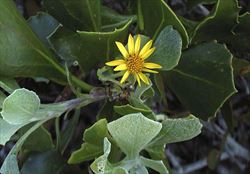
leaves, younger stems and flower-head (Photo: Jackie Miles and Max Campbell)
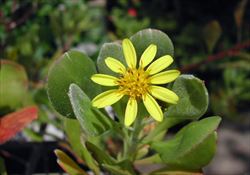
flower-head (Photo: Sheldon Navie)
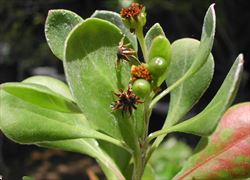
close-up of old flower-heads and immature fruit (Photo: Sheldon Navie)
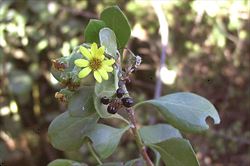
immature and mature fruit (Photo: Jackie Miles and Max Campbell)
Scientific Name
Chrysanthemoides monilifera subsp. rotundata (DC.) Norl.
Synonyms
Osteospermum rotundatum DC.
Family
Asteraceae (Queensland, New South Wales, the ACT, Victoria, Tasmania, Western Australia and the Northern Territory)Compositae (South Australia)
Common Names
bitou bush, bitoubush
Origin
Native to southern Africa (i.e. Cape Province and Natal in South Africa).
Cultivation
It was deliberately cultivated as a beach and sand stabiliser, and also as a garden ornamental, in the past.
Naturalised Distribution
Bitou bush (Chrysanthemoides monilifera subsp. rotundata) is widely distributed in the coastal regions of eastern Australia. It is mainly found in the coastal districts of south-eastern Queensland and along the coast of New South Wales. It has also been recorded in some parts of Victoria, in in south-western New South Wales, and on Lord Howe Island.
Habitat
Originally introduced to prevent soil erosion in coastal areas, this plant is most prevalent on sand dunes and in other coastal environments. It is a weed of sub-tropical and warmer temperate coastal districts and invades sand dunes, native bushland, open woodlands and rainforest margins.
Habit
A long-lived (i.e. perennial), densely branched, spreading (i.e. decumbent to ascending) shrub usually growing 1-2 m tall and 2-6 m across.
Distinguishing Features
- a spreading and slightly fleshy shrub, often found growing in coastal areas.
- it has white woolly young growth and almost rounded or spoon-shaped leaves with entire or slightly toothed margins.
- its yellow 'daisy-like' flower-heads usually have more than ten 'petals'.
- its fleshy fruit (6-9 mm across) turn blackish in colour as they mature and contain a single seed.
- these seeds are dark brown or blackish in colour (5-7 mm long) and have a ribbed surface texture.
Stems and Leaves
The stems of this plant are much-branched and green or purplish-green when young. They become woody with age, eapecially towards the base of the plant.
The leaves are alternately arranged, borne on stalks (i.e. petioles) 8-25 mm long, and tend to be slightly fleshy (i.e. semi-succulent) in nature. Newer leaves and young shhots often have a covering of dense white cottony down, while older leaves are mostly hairless (i.e. glabrous). The leaf blades (3-8 cm long anf 1.5-5 cm wide) vary from being oval (i.e. elliptic) to egg-shaped in outline (i.e. obovate) to nearly spoon-shaped (i.e. broadly spathulate). They generally taper towards the leaf stalk (i.e. they are cuneate) and their margins range from being entire to slightly irregularly toothed (i.e. dentate).
Flowers and Fruit
The flower-heads (i.e. capitula) are daisy-like with bright yellow 'petals' (i.e. ray florets) 8-13 mm long. These flower-heads (20-30 mm across) are borne in small clusters at the tips of the branches (i.e. in terminal panicles) and usually have more than ten (11-13) 'petals' (i.e. ray florets). Flowering occurs throughout the year, though mostly during the cooler late autumn and winter months.
The fleshy fruit (6-9 mm across) are green when young but as they mature their skins turn blackish in colour. Each fruit contains a single, hard seed. These seeds (5-7 mm long) are dark brown or blackish in colour, oval (i.e. ellipsoid) or egg-shaped (i.e. ovoid), and have a ribbed surface texture.
Reproduction and Dispersal
This plant reproduces mainly by seed, which are readily eaten and dispersed by birds. Seeds may also be spread by water, machinery, other animals (e.g. foxes, rabbits and ants), in contaminated soil, and in dumped garden waste.
Environmental Impact
Bitou bush (Chrysanthemoides monilifera subsp. rotundata) is a significant environmental weed in New South Wales and on Lord Howe Island, and an environmental weed or potential environmental weed in Queensland, Victoria, South Australia and Tasmania. It has been listed among the twenty Weeds of National Significance (WoNS) because of its invasiveness, potential for spread, and economic and environmental impacts. It is actively managed by community groups in New South Wales and Queensland, and was recently listed among the top 20 invasive plants in south-eastern Queensland.
Bitou bush (Chrysanthemoides monilifera subsp. rotundata) is an aggressive weed in coastal vegetation and primarily invades sand dunes, heathlands and nearby forests (i.e. open and closed sclerophyll woodlands and littoral rainforests). It poses a serious threat to native vegetation in these communities, where it can outcompete, and in many cases totally eliminate, the native flora. It grows faster than many native plants and forms a dense green blanket which can also prevent native plant regeneration. When it forms such dense stands it also destroys or drastically alters the habitat of native birds and animals. Bitou bush (Chrysanthemoides monilifera subsp. rotundata ) is of most concern along the New South Wales coast, where it has already degraded over 60% of the coastline. The invasion of native plant communities by bitou bush Chrysanthemoides monilifera subsp. rotundata) and boneseed (Chrysanthemoides monilifera subsp. monilifera) has also been declared as a "key threatening process" in New South Wales, and has been identified as a threat to the survival of a number of plant species and communities in this state.
Legislation
This species is declared under legislation in the following states and territories:
- ACT: C4 - prohibited pest plant (a pest plant whose propagation and supply is prohibited).
- New South Wales: Class 2 - a regionally prohibited weed. The presence of the weed must be notified to the local control authority and it must be eradicated from the land and the land must be kept free of the plant (on Lord Howe Island only), Class 3 - a regionally controlled weed. The relevant local control authority must be promptly notified of the presence of this weed and it must be fully and continuously suppressed and destroyed (in a large number of local authority areas), and Class 4 - a locally controlled weed. The growth and spread of this species must be controlled according to the measures specified in a management plan published by the local control authority and the plant may not be sold, propagated or knowingly distributed (in a large number of coastal local authority areas). See the New South Wales Department of Primary Industries Noxious Weeds List at http://www.dpi.nsw.gov.au for more detailed information on which local areas are covered in these declarations.
- Northern Territory: A - to be eradicated (throughout all of the Territory), and C - not to be introduced into the Territory.
- Queensland: Class 1 - introduction into the state is prohibited, and landowners must take reasonable steps to keep land free of this species (throughout the entire state). It is also illegal to sell a declared plant or its seed in this state.
- South Australia: Class 4@ - control of this weed must be undertaken throughout the entire state (trade and movement are also usually restricted throughout the state).
- Tasmania: D - the importation or sale of this species is prohibited and measures to reduce its population in an area, eradicate it from an area, or restrict it to a particular area may be required. Details on actual restrictions or measures for each declared weed are contained in the weed management plan for that species.
- Victoria: P4 - prohibited and must be eradicated or controlled (in the Mallee, North Central, West Gippsland and East Gippsland regions), and C6 - all reasonable steps must be taken to control the weed and prevent its spread (in the Wimmera, Glenelg, Corangamite, Port Phillip East, Port Phillip West and Goulburn regions).
- Western Australia: P1 - trade, sale or movement into the state prevented, and P2 - to be eradicated (throughout the entire state).
Management
For information on the management of this species see the following resources:
- the National Weeds Strategy Strategic Plan for bitou bush, which is available online at http://www.weeds.org.au/docs/bbbstrat.pdf.
- the Victorian Department of Sustainability and Environment Landcare Note on boneseed and bitou bush, which is available online at http://www.dse.vic.gov.au.
- the Biosecurity Queensland Fact Sheet on this species, which is available online at http://www.dpi.qld.gov.au.
- the Western Australian Department of Agriculture and Food information page on boneseed and bitou bush, which is available online at http://www.agric.wa.gov.au.
Similar Species
Bitou bush (Chrysanthemoides monilifera subsp. rotundata) and boneseed (Chrysanthemoides monilifera subsp. monilifera) can be distinguished by the following differences:
- bitou bush (Chrysanthemoides monilifera subsp. rotundata) is a low-growing, spreading plant with somewhat spoon-shaped (i.e. obovate or broadly spatulate) leaves that have entire or slightly toothed margins. Its flower-heads (i.e. capitula) usually have more than ten 'petals' (i.e. ray florets) and its seeds are dark brown or blackish in colour, oval or egg-shaped, and have a ribbed surface texture.
- boneseed (Chrysanthemoides monilifera subsp. monilifera) is a more upright plant with oval or almost rounded (i.e. elliptic or sub-orbicular) leaves that have coarsely toothed (i.e. serrate) margins. Its flower-heads (i.e. capitula) commonly have only five to eight 'petals' (i.e. ray florets) and its seeds are bone-coloured or light brown, almost round, and have a smooth surface texture.
Several of the native boobialla shrubs (e.g. Myoporum insulare and Myoporum boninense) may be confused with boneseed (Chrysanthemoides monilifera subsp. monilifera) because they have similar leaves and fruit. However, the boobiallas (Myoporum spp.) have small whitish flowers that are tubular in shape with five petal lobes, and their fruit are also usually purple in colour rather than black.
There are also some other yellow-flowered weeds from the 'daisy' family (i.e. Asteraceae) that may look similar from a distance. Ragwort (Senecio jacobaea), South African daisy (Senecio pterophorus) and fireweed (Senecio madagascariensis) have some similarity, as they also produce many showy, yellow, daisy-like flowers. However, these species are much smaller in stature with relatively narrow or deeply divided (i.e. dissected) leaves. Japanese sunflower (Tithonia diversifolia) is also slightly similar and can have a shrubby appearance. However, it can be distinguished by its larger flower-heads (usually greater than 10 cm diameter) and three-lobed leaves.

